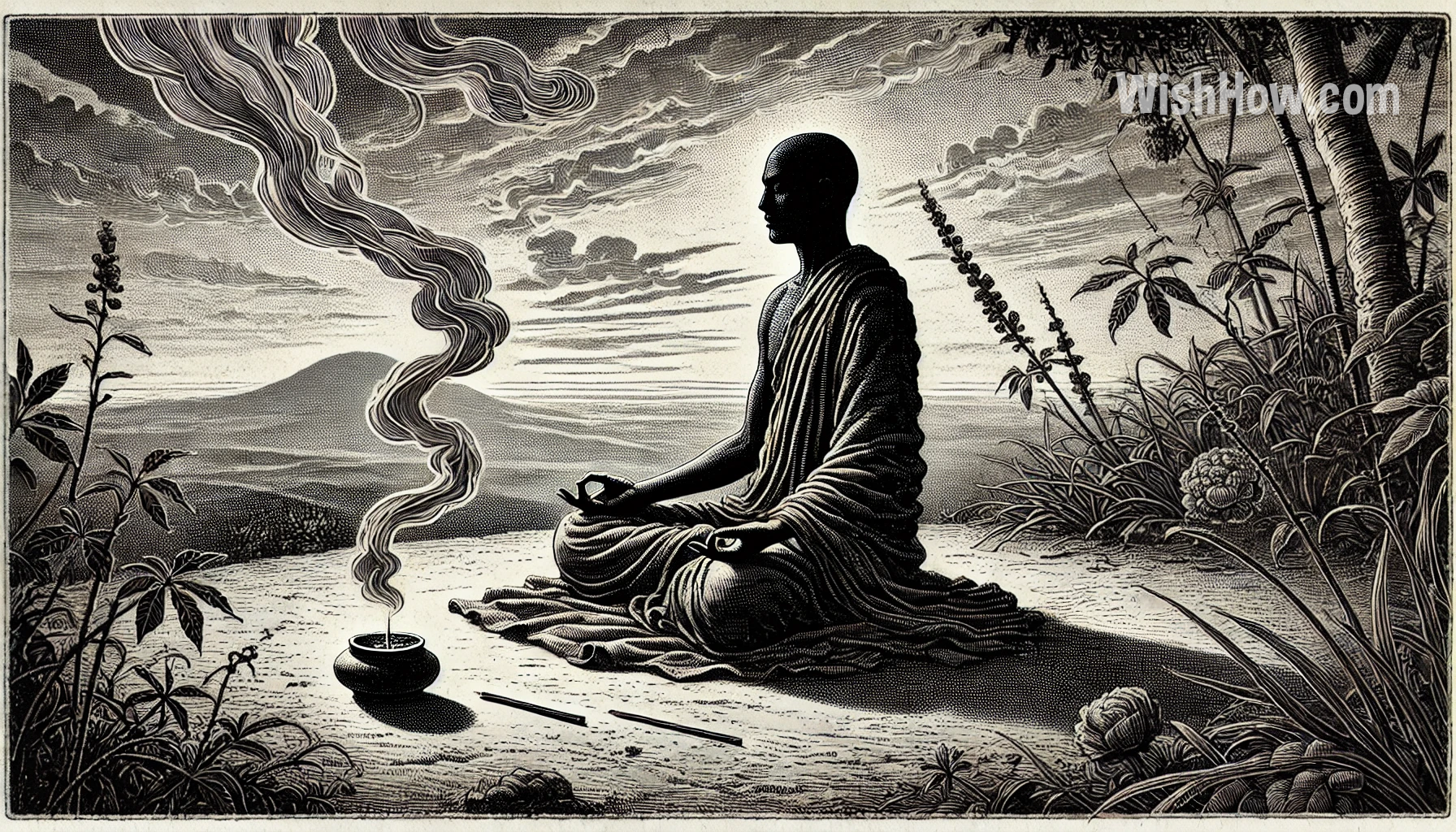Meditation is widely recognized as a powerful tool to enhance relaxation, mindfulness, and overall well-being. To deepen and enrich your meditation experience, incorporating sensory elements, such as incense, can be remarkably beneficial. In this detailed exploration, we examine the extensive benefits of using incense during meditation, provide practical tips for selecting the ideal fragrances, and share valuable insights to help you seamlessly integrate incense into your practice.
Why Meditation with Incense Matters
Meditation involves directing awareness inward and focusing on the present moment. Sensory inputs play a crucial role in guiding attention and enhancing concentration. Incense, with its gentle yet powerful fragrance, creates a sensory anchor that effortlessly pulls your awareness back whenever your mind begins to wander.
1. Creating a Relaxing Atmosphere
The most immediate benefit of using incense during meditation is its ability to create a peaceful and calming atmosphere. Aromas like lavender, sandalwood, and frankincense have well-documented calming effects. For instance, lavender has been scientifically proven to reduce stress, lower anxiety levels, and promote relaxation (Hongratanaworakit, 2011).
In addition, incense burning produces a subtle visual cue, further enhancing the tranquility of your meditation space. The slow, rhythmic rising of smoke can facilitate a sense of harmony and calmness, creating a soothing backdrop for meditation.
2. Enhancing Focus and Mindfulness
Incense serves as an excellent tool for mindfulness and improved concentration. The fragrant smoke acts as a sensory focal point, helping meditators return to the present moment, especially beneficial for beginners struggling with distraction. Scents such as sandalwood, cedarwood, or sage have been shown to enhance cognitive functions, sharpening the ability to concentrate and increasing cognitive clarity during meditation (Sayorwan et al., 2013).
3. Promoting Emotional Balance and Spiritual Connection
The olfactory stimulation provided by incense activates emotional pathways in the brain, promoting emotional stability, peace, and spiritual upliftment. Aromas such as rose, jasmine, and frankincense specifically support emotional health by alleviating stress, anxiety, and depression while promoting positivity and emotional well-being (Kiecolt-Glaser et al., 2008).
In many spiritual traditions, incense is used to create sacred spaces, cleanse negative energies, and foster a deeper spiritual connection. Whether used in religious rituals or personal spiritual practices, incense can significantly amplify the feeling of connection with oneself and the surrounding environment.
4. Ritualizing Your Meditation Practice
Introducing incense to your meditation routine helps ritualize the practice, providing a structured approach that enhances consistency and discipline. A regular practice, supported by sensory anchors like incense, becomes something practitioners look forward to, making meditation more habitual and less daunting. Meditation with incense creates a calming atmosphere that signals the mind it’s time to slow down and turn inward. Over time, meditation with incense can deepen your connection to the present moment, reinforcing a sense of peace and mindfulness each time you practice.
Mind Magic: The Neuroscience of Manifestation and How It Changes Everything
$20.86 (as of April 28, 2025 21:51 GMT -07:00 - More infoProduct prices and availability are accurate as of the date/time indicated and are subject to change. Any price and availability information displayed on [relevant Amazon Site(s), as applicable] at the time of purchase will apply to the purchase of this product.)5. Respiratory Health Benefits
Beyond mental and emotional benefits, certain incense types can offer significant physical health advantages. Aromas such as eucalyptus, peppermint, and camphor provide respiratory relief by clearing nasal passages, improving airflow, and easing breathing. This is particularly beneficial for breath-centered meditation techniques, enhancing overall practice effectiveness (Price & Price, 2007). When used intentionally, meditation with incense can create an atmosphere that supports deeper, more focused breathing. Incorporating specific scents into meditation with incense can also aid in reducing inflammation and boosting immune function, contributing to overall well-being.
6. Serving as a Natural Meditation Timer
A practical yet overlooked advantage of incense is its utility as a natural timer. A typical incense stick burns consistently for approximately 20 to 30 minutes. This eliminates the need for distracting clocks or timers, enabling practitioners to focus fully without the interruption of checking time. Utilizing this natural timing method, known as “one incense meditation,” supports deeper immersion into meditation sessions without reliance on digital devices. This is one reason why meditation with incense was a common practice among ancient monks and sages.

Choosing the Right Incense for Meditation
Selecting the right incense significantly impacts your meditation experience. Quality incense should be natural, sustainably sourced, and free from synthetic chemicals. Synthetic incense can cause headaches, respiratory irritation, and negatively affect your meditation. Opt for trusted brands that offer natural incense sticks or cones, clearly stating their ingredients and sourcing practices.
Popular Incense Types and Their Specific Benefits
- Sandalwood: Enhances focus, reduces anxiety, and promotes inner peace.
- Lavender: Known for relaxation, sleep improvement, and stress reduction.
- Frankincense: Widely used for spiritual practices due to its calming effects and ability to deepen meditative states.
- Jasmine: Encourages positivity, emotional warmth, and tranquility.
- Eucalyptus and Peppermint: Clears the respiratory system, enhancing breath-centered meditation practices.
- Sage: Traditionally used for cleansing energy and creating sacred spaces.
Practical Tips for Using Incense in Meditation
To fully benefit from meditation with incense, consider these practical tips.:
- Set up your space: Create a dedicated meditation corner with comfortable seating, soft lighting, and an incense holder.
- Choose your fragrance carefully: Experiment with various scents to determine what resonates best with your meditation style and emotional needs.
- Practice Safety: Always burn incense in a well-ventilated area, away from flammable materials. Ensure it is properly extinguished after use.
- Consistency: Regularly using incense helps condition your mind to associate the fragrance with relaxation, accelerating your ability to enter a meditative state quickly.
Also Read: What Are the Best Meditation Practices for Attracting Abundance?
Frequently Asked Questions (FAQs)
Q: Can incense improve meditation quality for beginners?
Absolutely. Beginners often struggle with wandering minds. Incense can anchor attention, making it easier to remain focused and engaged.
Q: Are there specific incense fragrances recommended for beginners?
A: Lavender, sandalwood, or frankincense are excellent starting choices due to their widely appreciated calming and grounding effects.
Q: Can incense have negative effects if used excessively?
A: Yes, prolonged exposure to smoke, even from natural incense, might irritate the respiratory tract. Moderation and proper ventilation are essential.
The Bhagavad Gita, 2nd Edition (Easwaran's Classics of Indian Spirituality Book 1)
$8.75 (as of April 28, 2025 21:51 GMT -07:00 - More infoProduct prices and availability are accurate as of the date/time indicated and are subject to change. Any price and availability information displayed on [relevant Amazon Site(s), as applicable] at the time of purchase will apply to the purchase of this product.)Environmental Considerations and Sustainable Choices
Environmental consciousness should also guide your choice of incense. Sustainable incense brands ensure their ingredients are ethically sourced and minimally impact the environment. Look for products with certifications like organic or fair trade to support ethical practices and sustainability. Choosing eco-friendly options not only benefits the planet but also enhances your experience during meditation with incense by aligning your practice with mindful living. When you support sustainable brands, your meditation with incense becomes a more holistic ritual that nurtures both your inner peace and the world around you.
Amplifying Visualization and Manifestation Through Meditation
Additionally, meditation significantly enhances visualization and manifestation practices. Through regular meditation, the mind becomes clearer and more focused, enabling practitioners to vividly visualize their desired outcomes with greater precision and emotional intensity. This heightened clarity allows individuals to align their intentions and energies more effectively, thereby accelerating the manifestation process. By cultivating mindfulness and reducing mental clutter, meditation supports a more powerful and intentional practice of visualization, helping transform goals and aspirations into reality.
Conclusion
Incorporating incense into your meditation routine offers numerous physical, emotional, and spiritual benefits. From enhancing relaxation and emotional balance to deepening mindfulness and spiritual connection, incense is an invaluable addition to any meditative practice. Choosing high-quality, natural products and practicing mindful usage ensures both effectiveness and safety, creating a consistently enriching meditation experience.
References
- Hongratanaworakit, T. (2011). Aroma-therapeutic effects of massage blended essential oils on humans. Natural Product Communications, 6(8), 1199-1204.
- Sayorwan, W., Ruangrungsi, N., Piriyapunyporn, T., Hongratanaworakit, T., Kotchabhakdi, N., & Siripornpanich, V. (2013). Effects of inhaled rosemary oil on attention and cognition. Scientia Pharmaceutica, 81(2), 531-542.
- Kiecolt-Glaser, J. K., Graham, J. E., Malarkey, W. B., Porter, K., Lemeshow, S., & Glaser, R. (2008). Olfactory influences on mood and autonomic, endocrine, and immune function. Psychoneuroendocrinology, 33(3), 328-339.
- Price, L., & Price, S. (2007). Aromatherapy for Health Professionals. Elsevier Health Sciences.







